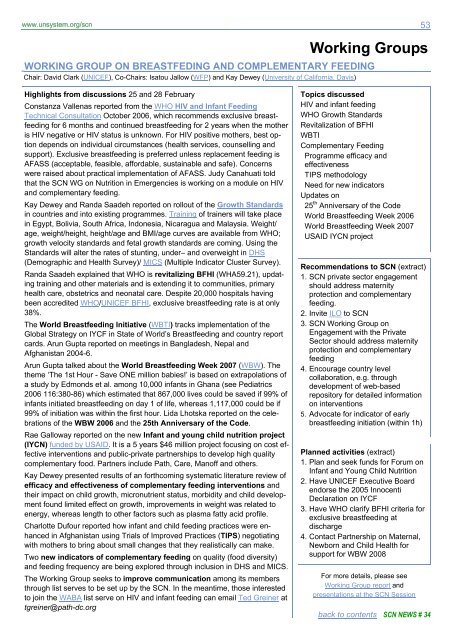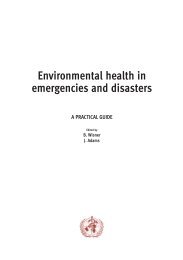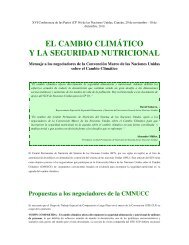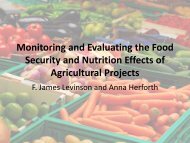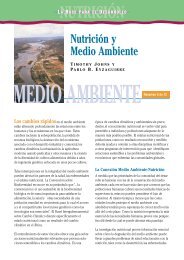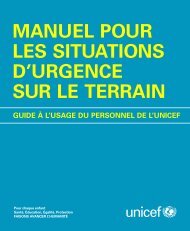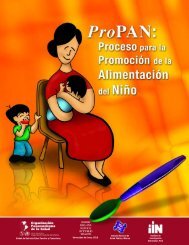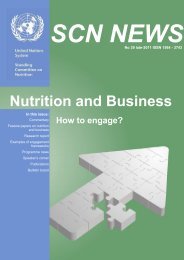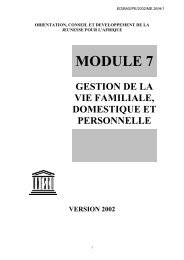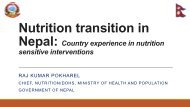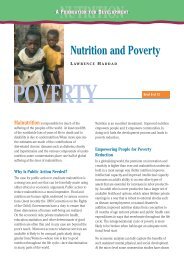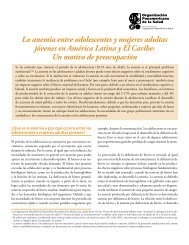SCN News No 34 - UNSCN
SCN News No 34 - UNSCN
SCN News No 34 - UNSCN
You also want an ePaper? Increase the reach of your titles
YUMPU automatically turns print PDFs into web optimized ePapers that Google loves.
www.unsystem.org/scn 53<br />
Working Groups<br />
WORKING GROUP ON BREASTFEDING AND COMPLEMENTARY FEEDING<br />
Chair: David Clark (UNICEF), Co-Chairs: Isatou Jallow (WFP) and Kay Dewey (University of California, Davis)<br />
Highlights from discussions 25 and 28 February<br />
Constanza Vallenas reported from the WHO HIV and Infant Feeding<br />
Technical Consultation October 2006, which recommends exclusive breastfeeding<br />
for 6 months and continued breastfeeding for 2 years when the mother<br />
is HIV negative or HIV status is unknown. For HIV positive mothers, best option<br />
depends on individual circumstances (health services, counselling and<br />
support). Exclusive breastfeeding is preferred unless replacement feeding is<br />
AFASS (acceptable, feasible, affordable, sustainable and safe). Concerns<br />
were raised about practical implementation of AFASS. Judy Canahuati told<br />
that the <strong>SCN</strong> WG on Nutrition in Emergencies is working on a module on HIV<br />
and complementary feeding.<br />
Kay Dewey and Randa Saadeh reported on rollout of the Growth Standards<br />
in countries and into existing programmes. Training of trainers will take place<br />
in Egypt, Bolivia, South Africa, Indonesia, Nicaragua and Malaysia. Weight/<br />
age, weight/height, height/age and BMI/age curves are available from WHO;<br />
growth velocity standards and fetal growth standards are coming. Using the<br />
Standards will alter the rates of stunting, under– and overweight in DHS<br />
(Demographic and Health Survey)/ MICS (Multiple Indicator Cluster Survey).<br />
Randa Saadeh explained that WHO is revitalizing BFHI (WHA59.21), updating<br />
training and other materials and is extending it to communities, primary<br />
health care, obstetrics and neonatal care. Despite 20,000 hospitals having<br />
been accredited WHO/UNICEF BFHI, exclusive breastfeeding rate is at only<br />
38%.<br />
The World Breastfeeding Initiative (WBTI) tracks implementation of the<br />
Global Strategy on IYCF in State of World’s Breastfeeding and country report<br />
cards. Arun Gupta reported on meetings in Bangladesh, Nepal and<br />
Afghanistan 2004-6.<br />
Arun Gupta talked about the World Breastfeeding Week 2007 (WBW). The<br />
theme ‘The 1st Hour - Save ONE million babies!’ is based on extrapolations of<br />
a study by Edmonds et al. among 10,000 infants in Ghana (see Pediatrics<br />
2006 116:380-86) which estimated that 867,000 lives could be saved if 99% of<br />
infants initiated breastfeeding on day 1 of life, whereas 1,117,000 could be if<br />
99% of initiation was within the first hour. Lida Lhotska reported on the celebrations<br />
of the WBW 2006 and the 25th Anniversary of the Code.<br />
Rae Galloway reported on the new Infant and young child nutrition project<br />
(IYCN) funded by USAID. It is a 5 years $46 million project focusing on cost effective<br />
interventions and public-private partnerships to develop high quality<br />
complementary food. Partners include Path, Care, Manoff and others.<br />
Kay Dewey presented results of an forthcoming systematic literature review of<br />
efficacy and effectiveness of complementary feeding interventions and<br />
their impact on child growth, micronutrient status, morbidity and child development<br />
found limited effect on growth, improvements in weight was related to<br />
energy, whereas length to other factors such as plasma fatty acid profile.<br />
Charlotte Dufour reported how infant and child feeding practices were enhanced<br />
in Afghanistan using Trials of Improved Practices (TIPS) negotiating<br />
with mothers to bring about small changes that they realistically can make.<br />
Two new indicators of complementary feeding on quality (food diversity)<br />
and feeding frequency are being explored through inclusion in DHS and MICS.<br />
The Working Group seeks to improve communication among its members<br />
through list serves to be set up by the <strong>SCN</strong>. In the meantime, those interested<br />
to join the WABA list serve on HIV and infant feeding can email Ted Greiner at<br />
tgreiner@path-dc.org<br />
Topics discussed<br />
HIV and infant feeding<br />
WHO Growth Standards<br />
Revitalization of BFHI<br />
WBTI<br />
Complementary Feeding<br />
Programme efficacy and<br />
effectiveness<br />
TIPS methodology<br />
Need for new indicators<br />
Updates on<br />
25 th Anniversary of the Code<br />
World Breastfeeding Week 2006<br />
World Breastfeeding Week 2007<br />
USAID IYCN project<br />
Recommendations to <strong>SCN</strong> (extract)<br />
1. <strong>SCN</strong> private sector engagement<br />
should address maternity<br />
protection and complementary<br />
feeding.<br />
2. Invite ILO to <strong>SCN</strong><br />
3. <strong>SCN</strong> Working Group on<br />
Engagement with the Private<br />
Sector should address maternity<br />
protection and complementary<br />
feeding<br />
4. Encourage country level<br />
collaboration, e.g. through<br />
development of web-based<br />
repository for detailed information<br />
on interventions<br />
5. Advocate for indicator of early<br />
breastfeeding initiation (within 1h)<br />
Planned activities (extract)<br />
1. Plan and seek funds for Forum on<br />
Infant and Young Child Nutrition<br />
2. Have UNICEF Executive Board<br />
endorse the 2005 Innocenti<br />
Declaration on IYCF<br />
3. Have WHO clarify BFHI criteria for<br />
exclusive breastfeeding at<br />
discharge<br />
4. Contact Partnership on Maternal,<br />
Newborn and Child Health for<br />
support for WBW 2008<br />
For more details, please see<br />
Working Group report and<br />
presentations at the <strong>SCN</strong> Session<br />
back to contents <strong>SCN</strong> NEWS # <strong>34</strong>


